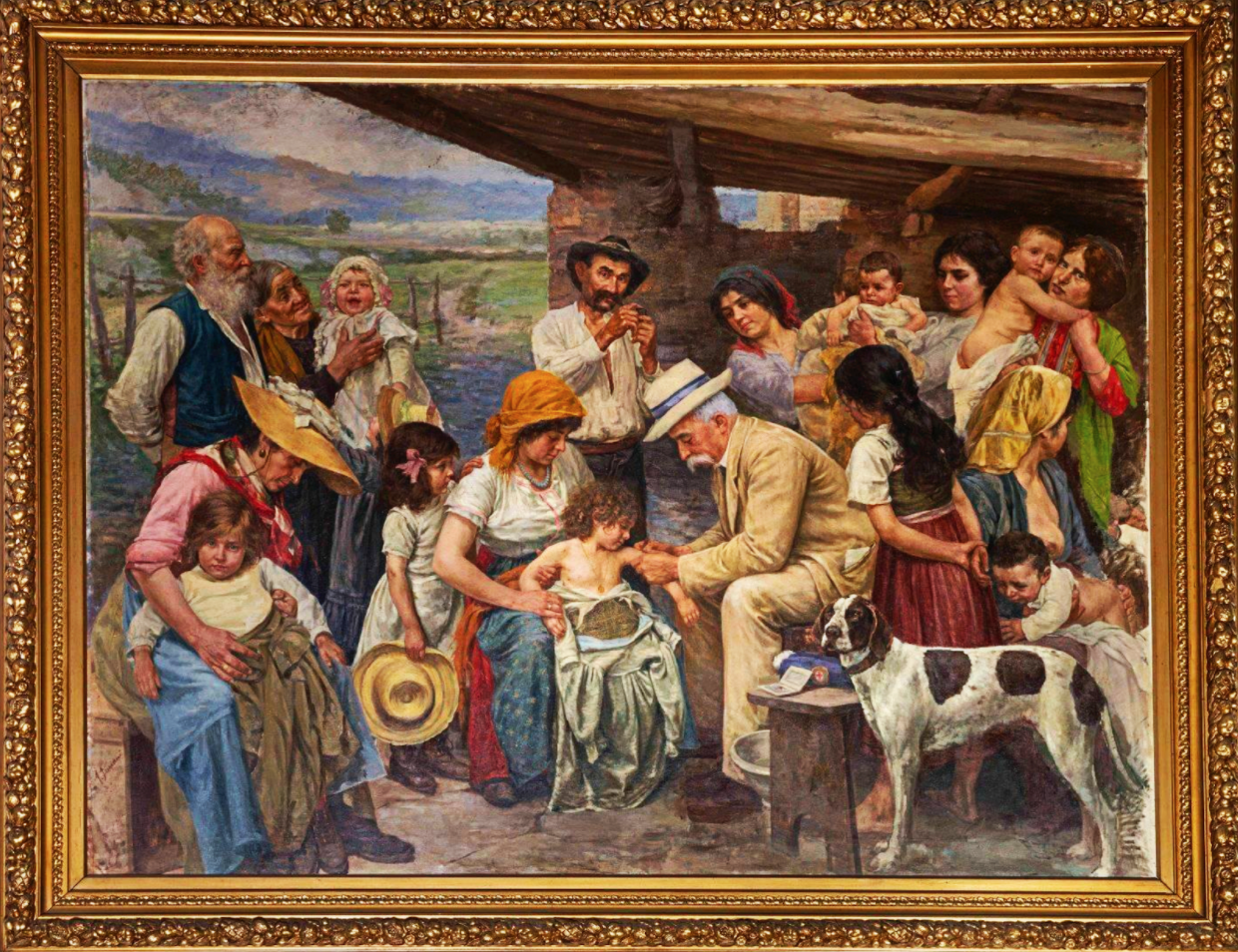I have published two other articles about the pandemic. The first was The COVID Pandemic: Finishing Unfinished Business in which I described how the pandemic affected every aspect of my life. The second, After Vaccination: Wear the Damn Mask! described the jubilation I felt when I was vaccinated, but cautioned that the pandemic was not over. I never expected that I would write a third article. I believed that everybody would jump at the once in a lifetime chance to be vaccinated, the result of brilliant science and innovation to stop this pandemic. I was wrong. Here is the third installment.
Almost exactly 50 years ago I graduated from medical school. I had learned the usual stuff about vaccination, but never spent a lot of time thinking about it until about 4 years ago. I was visiting a museum in Montalcino in Italy and high up hung a monumental painting (62 by 80 inches, I found out later) of a doctor vaccinating a child. The child being vaccinated looks curiously at what the doctor is doing. The child’s mother and sister are looking intently at the procedure. Several mothers and a grandmother are holding their children, waiting their turn for their children to be vaccinated. On the left side a young girl and on the right side a dog are looking directly at the viewer: “What are you waiting for?”
COVID, the disease caused by the virus SARS-CoV-2 and its variants, reignited my interested in vaccination. I eventually found out the painting’s name (Vaccination in the Sienese countryside), who painted it (Arturo Luciani (Montalcino, 1861 – 1936) but to this day I don’t really know why. But, i can take an educated guess. Here goes.

The child was being vaccinated to prevent smallpox (known scientifically as Variola Major). Smallpox is an ancient disease. Evidence of smallpox was found in Egyptian mummies! A brutal infection, caused by a virus, it killed about 20 to 50 percent of adults and 80 percent of children who got it. The survivors had immunity from reinfection. Hundreds of millions of people worldwide have died from smallpox.
A similar disease occurred in cows which sometimes infected people. On May 14, 1796, Edward Jenner (1749-1823), a British doctor performed an experiment in which he extracted pus from a sore of a cowpox-infected milkmaid and applied it to a few small scratches on the arm of an eight-year-old boy, who was then shown to be protected from getting smallpox. So was born the concept of vaccination, the term derived for the Latin vacca, for cow. This discovery led to the saving of more lives than any other event in medicine, because it also led to the introduction of vaccination for many other diseases.
In the 1800s there were improvements in producing smallpox vaccine. In the 1900s mass vaccinations were starting all over the world. Italy at the end of World War I was in the midst of a smallpox epidemic. Italy had 28,000 deaths between 1918 and 1920. Far more than any other country in Europe. I believe that the painting by Luciani was a celebration of vaccination. By 1929, smallpox was virtually eradicated from Italy. There was a recurrence of disease during World War II. By the 1950s Smallpox was eradicated from much of the world. The world is now free from smallpox. Vaccination works!
The COVID pandemic has made me think about my own experience with vaccination. I remember lining up, as a child, to be vaccinated when the Salk vaccine was first introduced to combat polio. I never got polio, a paralyzing, often fatal infection. I received the BCG vaccine to prevent TB. I never got TB even though I was exposed to many infectious patients in my career. I was vaccinated for hepatitis. I never got hepatitis. Before the widespread use of hepatitis vaccination, I recall a medical resident at a hospital I was training in dying of hepatitis that had destroyed his liver. For positions in hospitals, over the years, I had to present evidence of immunity (or immunization) for hepatitis, mumps, measles, chickenpox and influenza.
Symptoms of infections can linger, sometimes for decades. In 1990 I was treating patients who continued to have breathing failure 40 years after they had been infected with polio. I probably will never see another case of acute infection. Vaccination made that possible. Since 2018 new polio infection has virtually been eliminated from our planet!
The successive waves of COVID have killed many, left millions with lingering symptoms, and changed our lives. Some people are hesitant to be vaccinated for several reasons. Many people who are hesitant will change their mind. This has happened before with smallpox.
In Detroit, Michigan, in 1923, at a time when a less severe variety of smallpox (variola minor) was epidemic (710 cases over 6 months), the Health Department conducted a vigorous program to vaccinate the population of the city; this failed only about 6000 people were vaccinated each month. Soon, the dangerous form of smallpox (variola major) appeared; the vaccination rate increased dramatically, with 500,000 persons being vaccinated in one month and 800,000 (about 70% of the Detroit population) within 5 months. When people see danger to their families and communities, they react.
I now understand the painting by Luciani celebrating the fight against a deadly disease. Just as peoples’ actions and vaccines have defeated smallpox, they will defeat the SARS-CoV-2 virus and its variants. We will celebrate this victory and a return to normality.
References:
THE INCIDENCE AND CONTROL OF SMALLPOX BETWEEN 1900 AND 1958. https://biotech.law.lsu.edu/blaw/bt/smallpox/who/red-book/9241561106_chp8.pdf
HISTORY OF VACCINES: https://www.historyofvaccines.org/timeline#EVT_42Steljes DG, Kryger MH, Kirk BW, Millar TW. Sleep in postpolio syndrome. Chest. 1990;98(1):133-140. doi:10.1378/chest.98.1.133.


